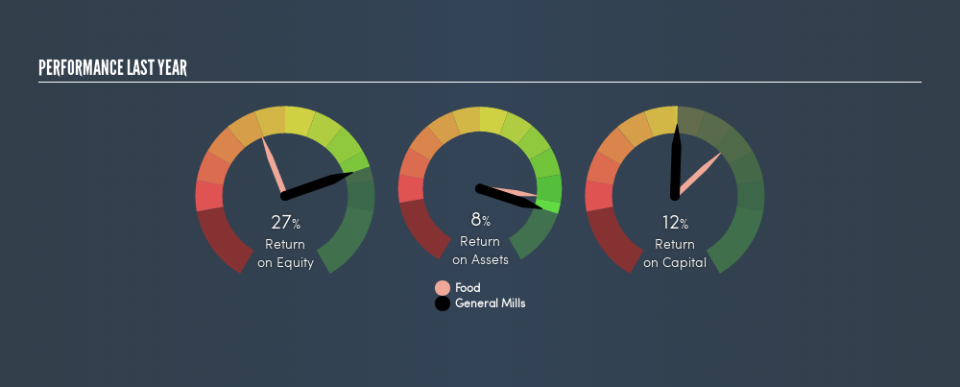What Can We Make Of General Mills, Inc.’s (NYSE:GIS) High Return On Capital?

Want to participate in a short research study? Help shape the future of investing tools and receive a $20 prize!
Today we’ll evaluate General Mills, Inc. (NYSE:GIS) to determine whether it could have potential as an investment idea. To be precise, we’ll consider its Return On Capital Employed (ROCE), as that will inform our view of the quality of the business.
First up, we’ll look at what ROCE is and how we calculate it. Next, we’ll compare it to others in its industry. Finally, we’ll look at how its current liabilities affect its ROCE.
Understanding Return On Capital Employed (ROCE)
ROCE is a metric for evaluating how much pre-tax income (in percentage terms) a company earns on the capital invested in its business. In general, businesses with a higher ROCE are usually better quality. Ultimately, it is a useful but imperfect metric. Renowned investment researcher Michael Mauboussin has suggested that a high ROCE can indicate that ‘one dollar invested in the company generates value of more than one dollar’.
How Do You Calculate Return On Capital Employed?
The formula for calculating the return on capital employed is:
Return on Capital Employed = Earnings Before Interest and Tax (EBIT) ÷ (Total Assets – Current Liabilities)
Or for General Mills:
0.12 = US$2.7b ÷ (US$30b – US$7.3b) (Based on the trailing twelve months to November 2018.)
So, General Mills has an ROCE of 12%.
See our latest analysis for General Mills
Is General Mills’s ROCE Good?
When making comparisons between similar businesses, investors may find ROCE useful. Using our data, we find that General Mills’s ROCE is meaningfully better than the 8.7% average in the Food industry. We would consider this a positive, as it suggests it is using capital more effectively than other similar companies. Separate from General Mills’s performance relative to its industry, its ROCE in absolute terms looks satisfactory, and it may be worth researching in more depth.
General Mills’s current ROCE of 12% is lower than its ROCE in the past, which was 18%, 3 years ago. Therefore we wonder if the company is facing new headwinds.
When considering this metric, keep in mind that it is backwards looking, and not necessarily predictive. Companies in cyclical industries can be difficult to understand using ROCE, as returns typically look high during boom times, and low during busts. This is because ROCE only looks at one year, instead of considering returns across a whole cycle. What happens in the future is pretty important for investors, so we have prepared a free report on analyst forecasts for General Mills.
Do General Mills’s Current Liabilities Skew Its ROCE?
Current liabilities include invoices, such as supplier payments, short-term debt, or a tax bill, that need to be paid within 12 months. Due to the way ROCE is calculated, a high level of current liabilities makes a company look as though it has less capital employed, and thus can (sometimes unfairly) boost the ROCE. To check the impact of this, we calculate if a company has high current liabilities relative to its total assets.
General Mills has total assets of US$30b and current liabilities of US$7.3b. As a result, its current liabilities are equal to approximately 24% of its total assets. Current liabilities are minimal, limiting the impact on ROCE.
Our Take On General Mills’s ROCE
Overall, General Mills has a decent ROCE and could be worthy of further research. But note: General Mills may not be the best stock to buy. So take a peek at this free list of interesting companies with strong recent earnings growth (and a P/E ratio below 20).
If you are like me, then you will not want to miss this free list of growing companies that insiders are buying.
We aim to bring you long-term focused research analysis driven by fundamental data. Note that our analysis may not factor in the latest price-sensitive company announcements or qualitative material.
If you spot an error that warrants correction, please contact the editor at editorial-team@simplywallst.com. This article by Simply Wall St is general in nature. It does not constitute a recommendation to buy or sell any stock, and does not take account of your objectives, or your financial situation. Simply Wall St has no position in the stocks mentioned. Thank you for reading.

 Yahoo Finance
Yahoo Finance 
